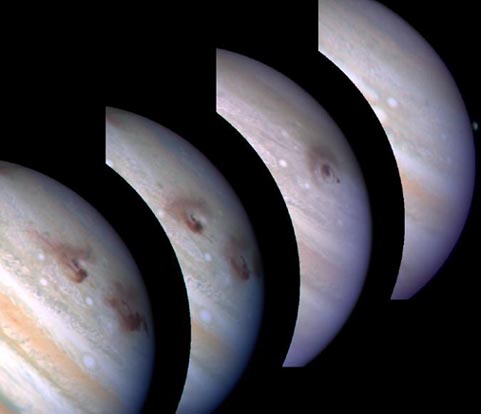برخورد دنباله دار شومِیکر-لِوی 9 (1) Comet Shoemaker-Levy 9 impact

دنبالهدار در شب 24 مارس سال 1993 کشف شد. کارولین، شومِیکر و لِوی[1] آن را در عکسی یافتند که بهوسیلۀ تلسکوپ ۴۰ سانتیمتری اشمیت واقع در رصدخانۀ کوه پولامور[2] در کالیفرنیا گرفته بودند. (آنها در حال اجرای برنامهای از یک سلسله رصدها برای کشف اجسام نزدیک به زمین بودند.)
تصاویر بسیار دقیق، مانند آنهایی که بهوسیلۀ تلسکوپ هابل گرفته شد، قطعاتی را در اندازههای ختلف، از چند صد متر تا 2 کیلومتر، نشان میداد. این قطعات برچسبهایی از A تاW دریافت کردند. تصور میشود که قطر اولیۀ دنبالهدار حدود ۵ کیلومتر بوده است. پس از بررسی دقیق مدار این قطعات، مشخص شد که آنها به احتمال بسیار زیاد در سال بعد و در مدت کمتر از یک هفته بهصورت مجزا به سطح مشتری اصابت خواهند نمود.
کتاب درآمدی بر نجوم و کیهان شناسی صفحه ۱۴۰
Perhaps the most exciting event in recent Jovian history was when the fragments
of Comet Shoemaker-Levy 9 impacted on its surface in July 1994 .
It is thought that Jupiter had captured the comet in the late 1960s or early 1970s
so it had become a temporary satellite of Jupiter orbiting it once every 2 years or
so. It appears that the comet had passed within 40 000 km of Jupiter’s surface on
July 7, 1992. This distance is within what is called the Roche limit of the planet
within which the gravitational forces acting on the comet were able to break it up
into a number of fragments. If a body has a particular size, the force of gravity
acting on those parts of the body furthest from the centre of mass of a nearby
planet will be less than that on the nearer parts. A differential ‘tidal’ force thus
acts across the body. If this force is greater than the gravitational forces keeping
the body whole, the body will break up into smaller parts. As Jupiter is very mas-
sive, its tidal forces are very great and also have a signifi cant effect on Jupiter’s
innermost Galilean moon, Io.
The comet was discovered on the night of March 24, 1993 by Carolyn and
Eugene Shoemaker and David Levy in a photograph taken with the 0.4 m Schmidt Telescope at the Mount Palomar Observatory in California. (They were conducting
a programme of observations designed to uncover NEOs.)
High resolution images, such as that made by the Hubble Space Telescope,
showed a number of fragments (labelled A to W) which ranged in size from a
few hundred metres up to 2 km. It is thought that the initial diameter of the
comet would have been about 5 km. As the orbits of the fragments were refi ned,
it became apparent that they were very likely to impact on the surface of Jupiter
the following year with the individual impacts to be spread out over just under
a week.
"Introduction to Astronomy and Cosmology" Page 110 -111
 بنام آفریدگار بی همتا
بنام آفریدگار بی همتا